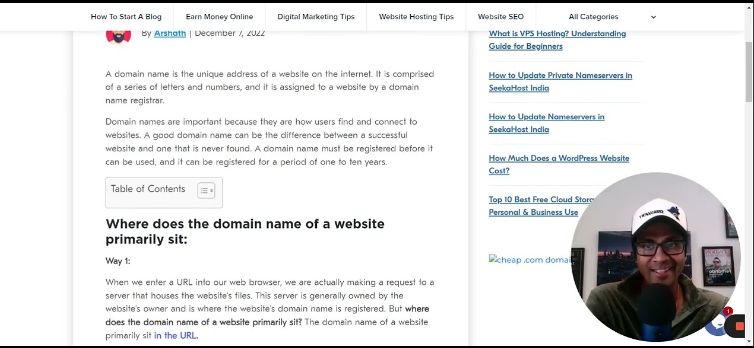Where Does the Domain Name of a Website Primarily Sit? What You Need To Know

A website’s domain name resides in the DNS or Domain Name System. It is the address where internet users can access your website.
Navigating the digital spaces of the Internet is like exploring a vast city where every building needs a unique identifier—that’s where domain names come in. They are the key to unlocking digital destinations, making websites accessible with memorable names rather than complex numerical IP addresses.
This system is crucial for creating a user-friendly and searchable web. By fostering brand recognition and trust, the right domain name is the foundation of a solid online presence, crucial for marketing and search engine visibility. It translates the technical IP into human-readable text, ensuring a smooth online experience. Therefore, picking an accurate, evocative domain name is one of the first steps in establishing a successful online identity for any venture.
Contents
- 1 The Essence Of Domain Names
- 2 Domain Name System (DNS) Deciphered
- 3 Registrars And Registries: Domain Name Custodians
- 4 The Anatomy Of A Url
- 5 Hosting Services: Storing The Website’s Content
- 6 Life Cycle Of A Domain Name
- 7 Managing Domain Names
- 8 Security Measures For Domain Names
- 9 The Future Of Domain Names
- 10 Conclusion
The Essence Of Domain Names
The Essence of Domain Names lies at the very heart of the Internet’s architecture. Think of domain names as your online address. They guide users to your digital doorstep. Every website requires a unique domain name, which ensures visitors can find and revisit the site without confusion.
What Makes A Domain Name
A good domain name is:
- Memorable: Easy for users to recall.
- Concise: Short and to the point.
- Relevant: Reflects your brand or content.
- Credible: Builds trust with users.
- Intuitive: Users can guess it based on your brand.
A domain name has several parts:
| Part | Description |
| Top-Level Domain (TLD) | The last part is like .com or .org. |
| Second-Level Domain (SLD) | You choose the unique section. |
| Subdomains | Optional additions like ‘blog’ or ‘shop’. |
Domain names serve as a critical navigation tool by:
- Directing users to your site with an easy-to-remember address.
- Using DNS to convert user-friendly names to IP addresses.
- Helping establish brand identity and presence online.
- Enabling search engines to index and rank your site.
- Boosting marketing and communication efforts.
Well-chosen domain names make web navigation intuitive. They turn a complex IP address into a simple, branded pathway. In a crowded digital world, distinctive domain names stand out. They are essential to user experience, search visibility, and brand recognition.
Domain Name System (DNS) Deciphered
The Domain Name System, or DNS, might seem complex. Still, it’s simply the Internet’s way of turning user-friendly domain names into IP addresses that computers use to identify each other. Think of DNS as the essential component that allows humans and machines to speak the same language when looking for websites and sending emails.
DNS: The Internet’s Address Book
DNS serves as the cornerstone of internet navigation. Without it, we’d be memorizing strings of numbers for every website we want to visit. Instead, DNS does the hard work, maintaining a directory of domain names and their corresponding IP addresses.
- Stores information about domain names
- Matches domain names with IP addresses
- Ensures users reach the correct website
How Dns Translates Domain To Ip Address
Here’s the magic: DNS translates the domain name you type into the browser into the IP address networks use to locate the website’s server. It’s like dialling a friend’s name on your phone and having it convert to their number.
- You type in a web address.
- DNS looks up the domain’s IP address
- Your browser uses the IP to load the website
Registrars And Registries: Domain Name Custodians
Embarking on a digital journey starts with selecting a unique identifier: the domain name. This digital asset’s administration is crucial. Two key players are domain registrars and registries. They ensure every domain name links to a distinct online space.
Function Of Domain Registrars
Domain registrars serve as the essential point of contact for domain name purchasers. They work with individuals and organizations to register domain names. Below is a breakdown of their essential functions:
- Facilitate the purchase and renewal of domain names.
- Offer management tools for DNS settings.
- Provide customer support and service.
The Purpose Of Domain Registries
Domain registries hold the master list of all domain names registered in a particular domain space, like .com or .org. See their purpose outlined in the table below:
| Registry Function | Description |
| Maintain the database | All registered domain names and associated information in their zone are stored. |
| Operate the TLD | Ensure the top-level domain (TLD) is functioning correctly. |
| Set policies | Define rules that govern how domain names can be used and registered. |
The Anatomy Of A Url
Understanding a URL’s structure is crucial for web navigation and SEO optimization. A URL, or Uniform Resource Locator, gives you the information needed to find a webpage. It signifies a resource on the Internet, leading users directly to its location using a web browser. Knowing what each part represents can elevate user experience and search engine ranking.
Breaking Down The Parts Of An Url
Each URL has distinct sections that serve specific purposes. Let’s dissect one piece at a time:
- Protocol: Usually HTTP or HTTPS, this tells the browser how to fetch a resource.
- Subdomain: It’s the ‘www’ or other prefix before the domain name.
- Domain Name: The identity of the website, which is unique and registered.
- Top-Level Domain (TLD): This follows the domain name, like ‘.com’ or ‘.org’.
- Path: Directs to specific content on the website, such as a page or section.
- Parameters: These start with a ‘?’ and contain additional details that sites use.
- Fragment: An optional part that jumps to a specific part of the page with ‘#’.
How Domain Names Fit Into URLs
A domain name is more than just a web address. It’s a critical SEO element, branding tool, and identity marker for any website. Within a URL, the domain name chiefly occupies the central position, acting as a signpost for search engines and visitors. It falls right after the protocol but before the path or any following components. It’s the ‘home base’ of a website.
| URL Part | Description |
| Protocol | How resources are retrieved |
| Domain Name | The unique identifier in a URL |
| Path | Leads to a specific part of the site |
In summary, the domain name serves as the cornerstone of a URL, guiding users to the right destination. While many elements make up a URL, the domain name often stands out for its branding and memorability.
Hosting Services: Storing The Website’s Content
Think of your website as a house. Just as a house needs a piece of land to sit on, your website needs a space online. This space is known as web hosting. Hosting services provide the land where your website’s files, images, and content live. They ensure your site stays up and running so visitors can stop by at any time.
The Connection Between Domain Names And Web Hosting
Your domain name is the address people use to find your website. A web host is where your website’s content is stored. The two work together. When someone types in your domain name, the hosting service’s servers show your website’s content.
Key points of this relationship include:
- Domain names are leased from domain registrars.
- Hosting services store the actual website files.
- Servers connect domain names to the hosted site content.
Integrating Domain Name With Web Hosting Provider
To get your website online, link your domain name to your hosting account. This linkage is crucial for your website to function correctly.
Steps to integrate:
- Choose a reliable web hosting provider.
- Select a hosting plan that meets your needs.
- Set your domain name’s DNS to your host’s servers.
Note: Some providers offer domain registration and hosting together. This can simplify the process.
Life Cycle Of A Domain Name
Understanding the journey of a domain name helps in making intelligent decisions. A domain name’s life is an entire of stages. Let’s explore the critical phases from starting to fading away. It’s a cycle every website owner should know.
From Registration To Expiration
Choosing and registering a domain is the first step in carving out your own space on the Internet Internet. Your chosen domain stays active for the period you decide, which could be one year, two years, or more. The end of this period marks the expiration date.
- Pick your domain name: Find the perfect web address for your site
- Register it: Through a domain registrar, legally own your domain
- Set the duration: Decide how long before your domain needs renewal
- Receive confirmation: Get the details and expiration notice via email
Renewal And Redemption Periods
After expiration, your domain enters a grace period. You can still renew it, usually for 30 days. Miss this, and you hit the redemption phase. This is your last chance to reclaim your domain, but it will cost extra.
| Stage | Timeframe | Action Needed |
| Grace Period | Up to 30 days post-expiration | Renew domain at regular price |
| Redemption Phase | Typically 30-90 days post-grace period | Redeem the domain with an additional fee |
If you miss the redemption, your domain name will be released to the public again. Anyone can register it. Act fast or say farewell to your domain.
Managing Domain Names
Managing domain names is crucial for any website owner. It involves setting up, maintaining, and sometimes transferring your digital address. A well-managed domain ensures your website remains accessible and that you maintain ownership without interruption.
Domain Name Configuration
Configuring your domain name is the backbone of a strong web presence. This setup decides how internet users find your website. It includes setting DNS records that point to your hosting server and configuring email addresses linked to your domain.
- A-record: Links your domain to your hosting IP address.
- CNAME: Allows you to point subdomains to other domain names.
- MX-records: Directs your email to your chosen email provider.
Transferring And Updating Domains
Transferring a domain can refresh your web identity. It might be necessary after a rebrand or if you seek better service elsewhere. Keep your domain details current to avoid lapses in ownership.
| Step | Action | Outcome |
| 1 | Unlock your domain | Prepares the domain for transfer |
| 2 | Get the transfer code | It’s the key to initiate a transfer |
| 3 | Update administrator contact information | Ensures you receive all transfer notifications |
Remember to renew your domain name before it expires. This keeps your site live and prevents others from claiming your URL. When updates or transfers are needed, act swiftly to execute changes for a seamless transition.
Security Measures For Domain Names
Every website owner must protect their virtual real estate. Domain names face threats online, just like physical properties do. Your domain name is your identity on the web, so safeguarding it would help. Security measures for domain names prevent unauthorized access and cyber-attacks. Let’s dive into what keeps your domain secure, from domain hijacking to SSL certificates.
Protecting Against Domain Hijacking
Domain hijacking is a serious threat. Hackers steal domains to take complete control. This can hurt your business and reputation. Protect your domain with these steps:
- Registrar lock: Enable it to prevent unauthorized transfers.
- Two-factor authentication: Add an extra security layer at your registrar.
- Regularly update details: Keep your contact information current.
- Monitor your domain: Watch for any unauthorized changes.
Secure Socket Layer (SSL) Certificates And Domain Names
Your domain name pairs with an SSL certificate to secure user data. Visitors trust secure sites more. Here’s how SSL certificates help:
| Aspect | Benefit |
| Encryption | Protects data exchange between user and site. |
| Authentication | Assures visitors they are on the correct site. |
| Trust indicators | Shows a security padlock in the browser address bar. |
Secure your domain with an SSL. It encrypts data and builds trust. Choose a reliable SSL provider for the best results.
The Future Of Domain Names
The Internet is ever-evolving, and the world of domain names keeps pace. Innovations and changes shape how we think about URLs. How will these changes influence the way websites are found online? Let’s dive into the emerging trends and new top-level domains that could reshape the Internet’s address system shortly.
Emerging Trends In Domain Name Registration
The landscape of domain name registration is brimming with fresh patterns. Key trends include:
- Personalization: Names that reflect personal brands are on the rise.
- Localization: Local businesses seek names with local relevancy.
- Memorable Extensions: Creative extensions beyond traditional .com, .org, or .net are gaining popularity.
- SEO-Friendly Names: Domains optimized for search engines help sites climb rankings.
- Blockchain-Based Domains: These offer decentralized control and increased security.
The Impact Of New Top-level Domains (TLDs)
New TLDs are expanding digital real estate. Their impact includes:
- Enhanced Branding: Businesses echo their endeavours in TLDs like .app, .tech, or .health.
- Diversity in Names: More TLD options mean more chances to secure the perfect domain.
- SEO Opportunities: Specific TLDs can improve search visibility for relevant queries.
Such innovations broaden the domain name system’s horizons and bring fresh challenges and opportunities to website owners, developers, and brands online.
Conclusion
Understanding a domain name’s place in online navigation is essential for any digital presence. It resides with your domain registrar, anchoring your site’s identity. Maximizing its potential requires thoughtful selection and management. Remember, a strategic domain sets the stage for successful online engagement.



